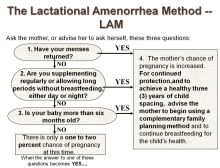The Lactational Amenorrhea Method (LAM) for postpartum contraception
I was so very fortunate enough to meet Prof. Miriam Labbok on a speaking tour I organised with the team from the Lactation Resource Centre for the Australian Breastfeeding Association in 2012. I was also very sad to hear that Miriam passed away earlier this year, 2016. Thank you for all you have done for the women of the world.
I share the following article for your information and continual sharing with your family, friends and colleagues.
The Lactational Amenorrhea Method (LAM) for postpartum contraception
By Miriam H Labbok, MD, MPH, FACPM, IBCLC, FABM
The Lactational Amenorrhea Method, known as LAM, is part of the World Health Organization’s list of accepted and effective methods of family planning. Studies show LAM to be 98% effective, as effective as the pill and other modern methods, when used according to guidelines.
How did the old wives’ tale that breastfeeding can help prevent a pregnancy evolve into a well-tested modern method of contraception? Since the 1970s there has been much study of the relationship between breastfeeding and fertility. First, national surveys began to find this relationship. Later, studies confirmed this: women who fully breastfeed are less likely to experience a normal ovulation prior to the first menstrual-like bleed than are women who partially breastfeed their babies or who don’t breastfeed at all. [Different breastfeeding mothers will start to menstruate at different times after giving birth. For some breastfeeding mothers, their period returns as early as a few weeks after giving birth and for others it can take years. The time during which breastfeeding suppresses menstruation and fertility is called lactational amenorrhea].
Three criteria can be used to predict the return of your fertility.
-
Have you had a menstrual bleed? (for the purposes of LAM this is defined as any bleeding, on any two consecutive days, that occurs 2 months after the birth)
-
Are you giving regular supplementary foods or foods or fluids to your baby in addition to breastfeeding?
-
Is your infant older than 6 months of age?
If you answer no to all the above three questions, then you meet the requirements for the LAM.
The baby’s age of 6 months is a somewhat arbitrary choice, but it has been chosen because 6 months is the period during which the World Health Organization recommends mothers exclusively breastfeed for and after which time complementary foods are begun. However, studies have shown that, if women achieve 6 months of successful LAM use, continue their breastfeeding frequency when they introduce complementary feeding, and breastfeed first before the complementary food at each feeding, they may have continued high efficacy of the LAM.
If the mother is interested in and qualifies for LAM, she is advised to continue to ask herself the same three questions. If she answers yes to any of these three questionsshe should begin to use another form of contraception to delay conception. It is a good idea to ensure that she has an alternative method of contraception at hand and initiates its use whenever her answers to any of the three questions changes. She also should be advised to contact her health care professional immediately if she has any questions as to whether or not the LAM method is best for her, as it does not protect against sexually transmitted diseases.
Without proper orientation to the method, LAM may be confused with breastfeeding alone, or with lactational amenorrhea alone, neither of which provides reliable protection against pregnancy. LAM can be illustrated via a series of questions in this flow chart. (Fig 1) It shows the three criteria for defining the period of lowest pregnancy risk. This figure advises the immediate commencement of another method of contraception if any one of the three criteria is not met.

Figure 1
One of the most common issues that mothers will raise is the variability that occurs in normal breastfeeding. Figure 2 defines full or nearly full breastfeeding, the pattern needed for LAM success, and shows the impact on fertility of different patterns and frequency of breastfeeding.

Figure 2
LAM has been widely accepted as a natural family planning method that demands no abstinence. It is used as an introductory method for the postpartum period for the breastfeeding woman who hesitates to use a hormonal or chemical method. It has the added benefit of encouraging optimal breastfeeding behaviour, providing support for the health of the mother and the child.
Miriam Labbok, MD, IBCLC, is Professor, Department of Maternal and Child Health, Director, Carolina Global Breastfeeding Institute (CGBI), Gillings School of Global Public Health at the University of North Carolina Chapel Hill, NC USA.
This article is a summary of research and many articles by Professor Labbok. It also draws on the Academy of Breastfeeding Medicine’s recent protocol on contraceptive use during breastfeeding and a chapter in Breastfeeding, Fertility, and Family Planning, which may be accessed at: http://www.glowm.com/index.html?p=glowm.cml/section_view&articleid=396
Yours in Health and Happiness

Sandy B.
